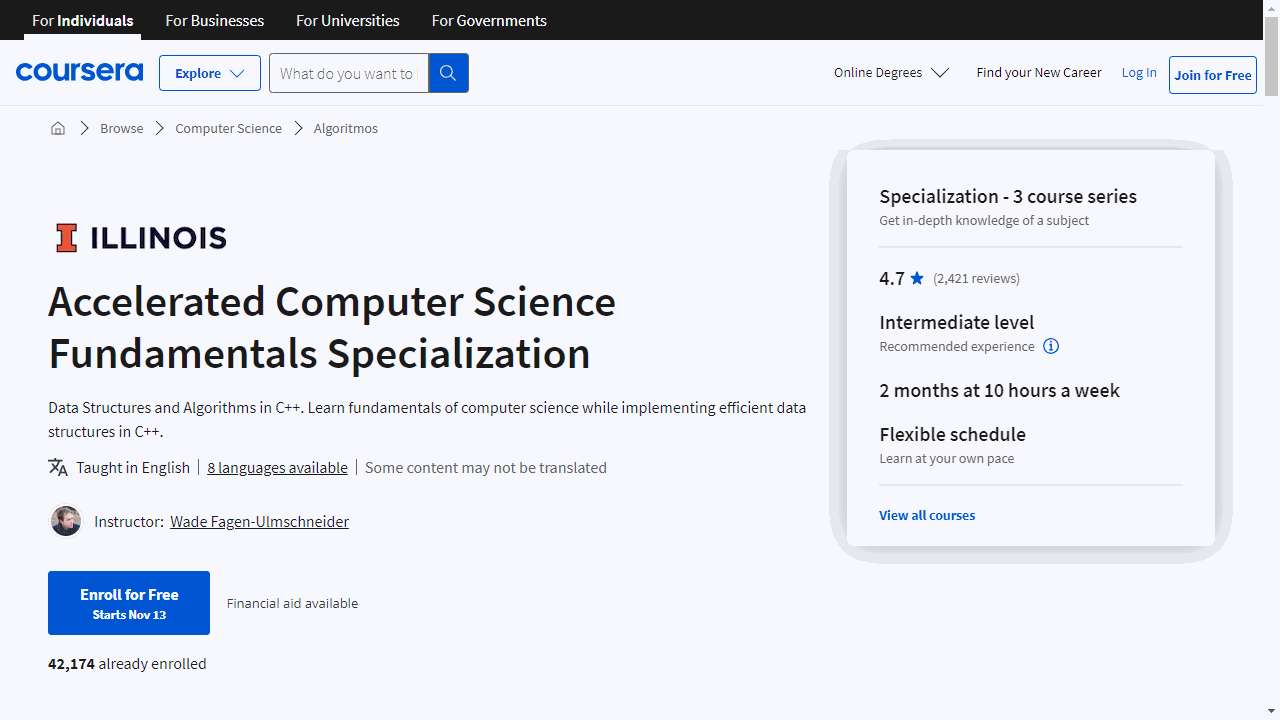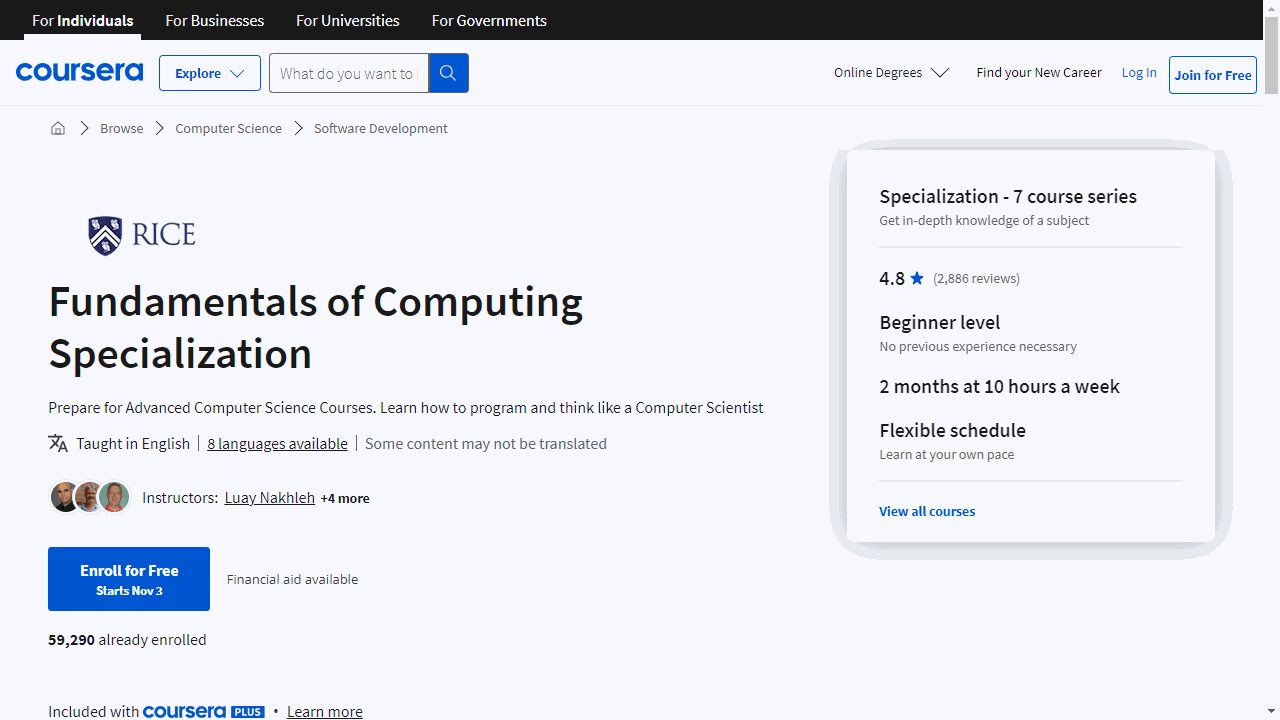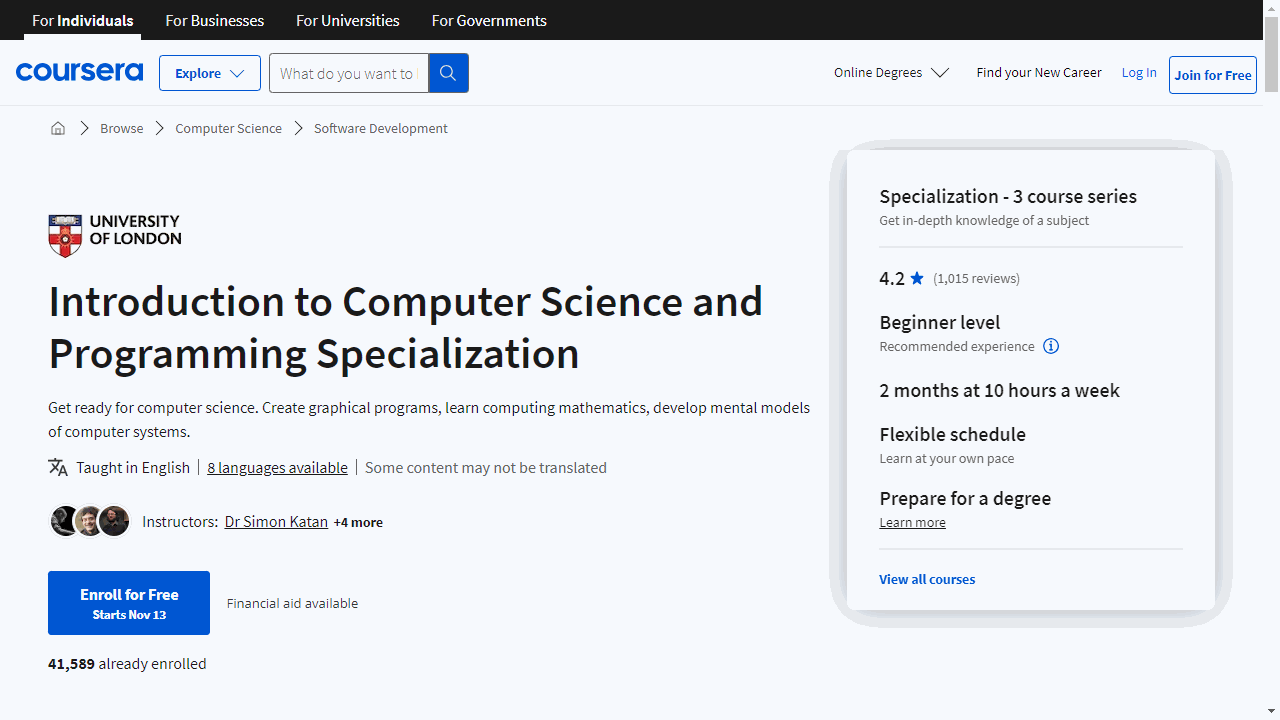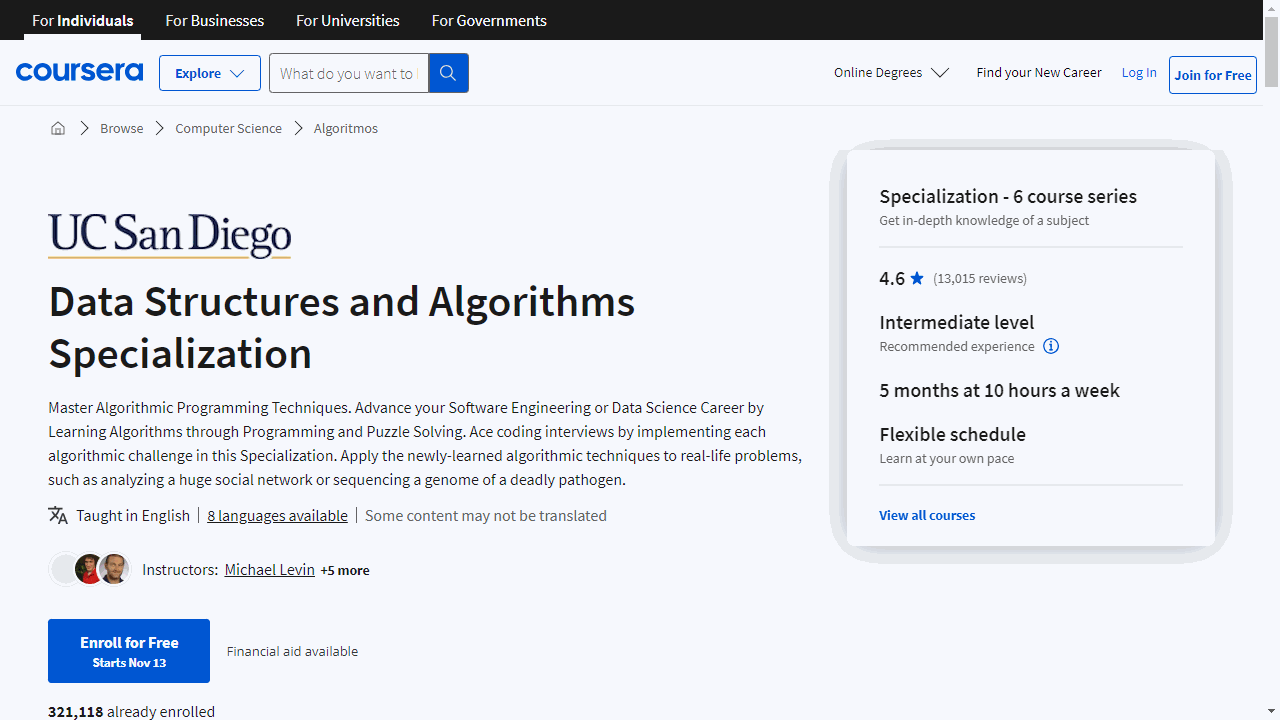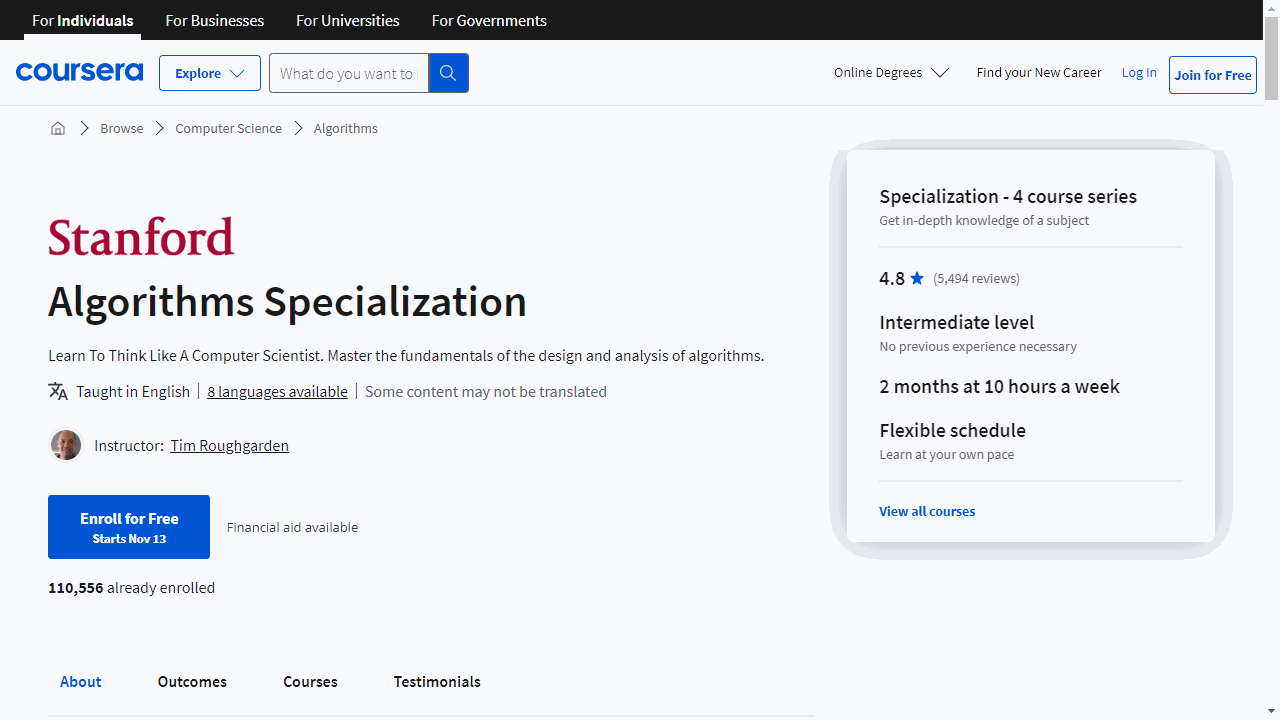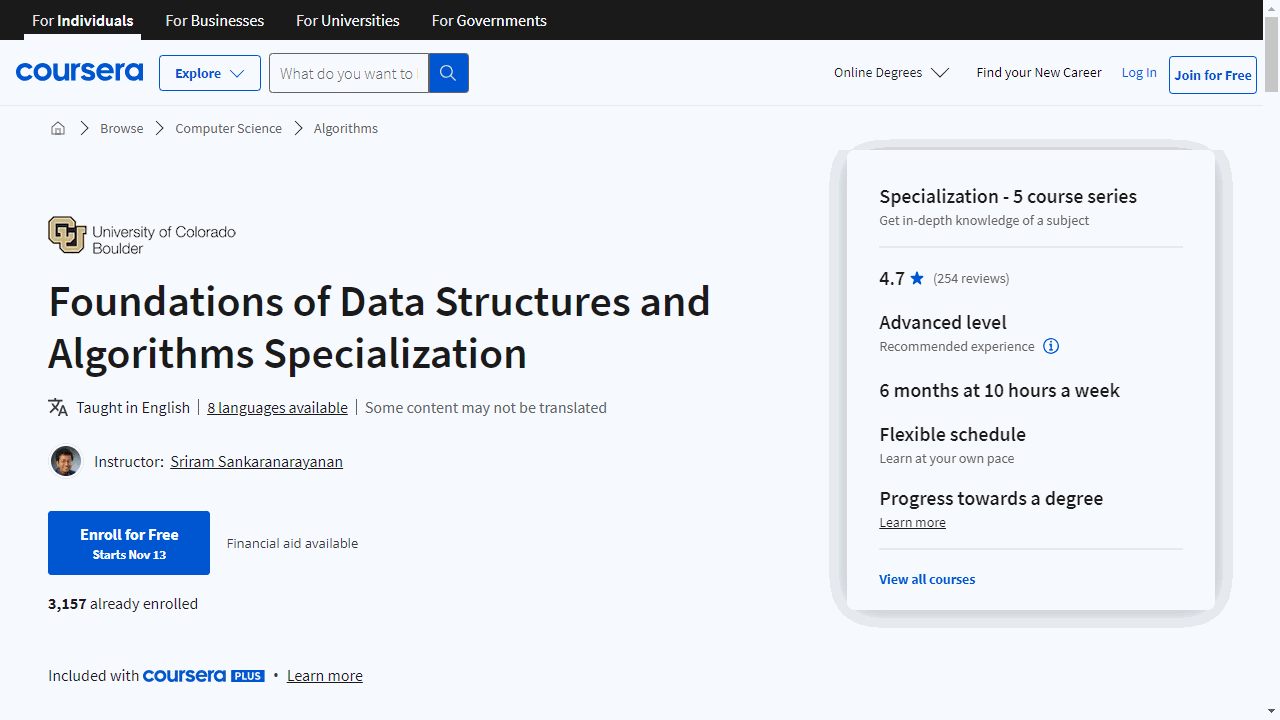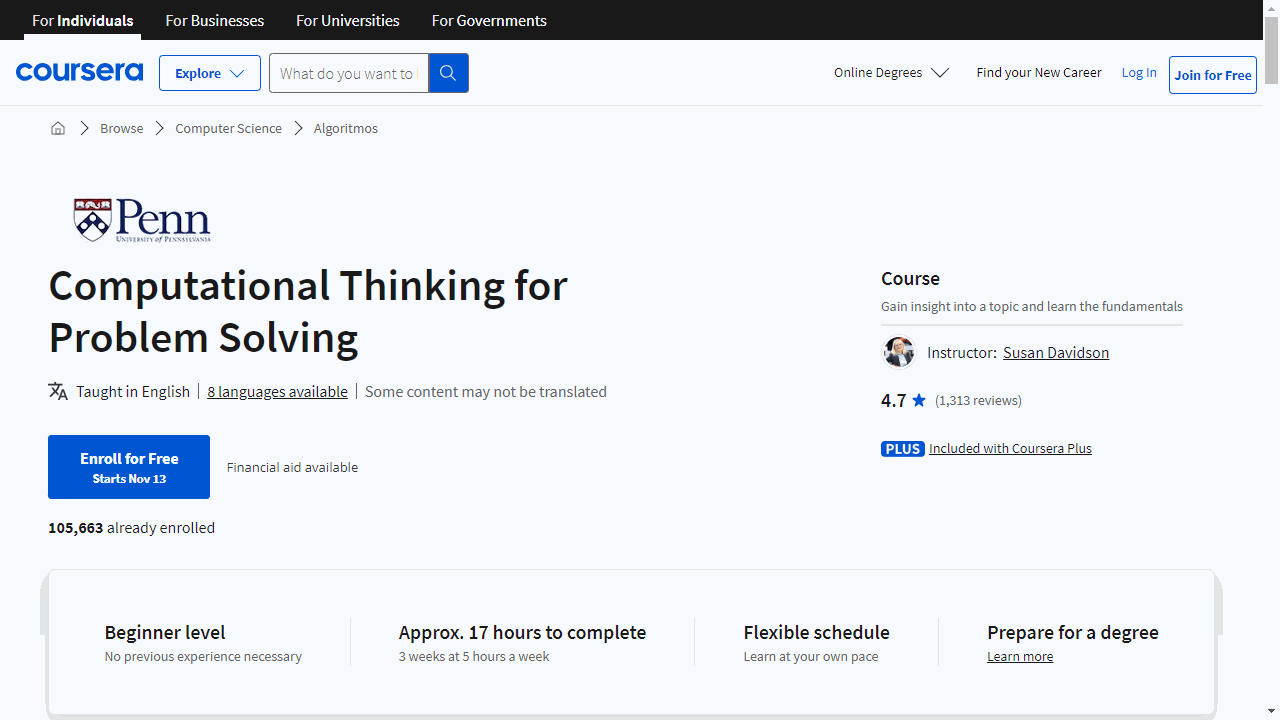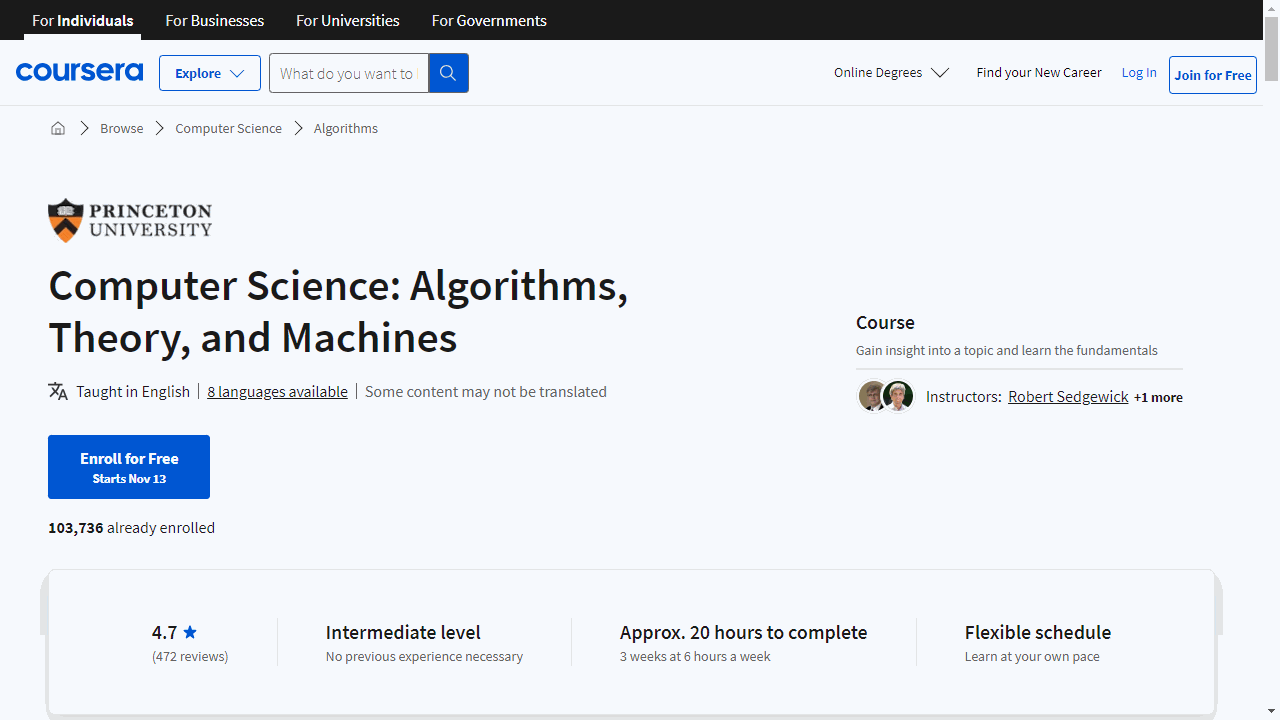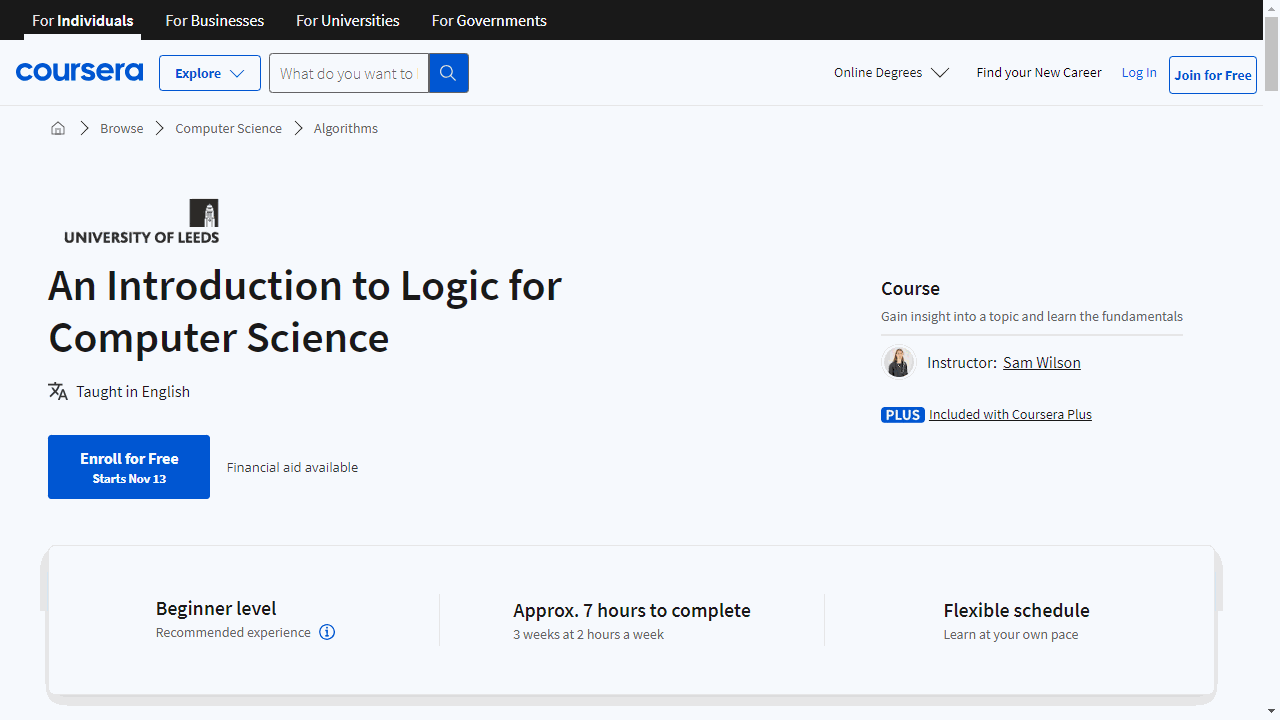Computer science is the study of how to design and build computer systems, and it’s an incredibly exciting and rewarding field.
By learning computer science, you can unlock the ability to create software, develop new technologies, and solve complex problems using the power of computation.
You can even use your skills to build amazing things, like websites, apps, and games!
Finding the right computer science course on Coursera can be a challenge, with so many options to choose from.
You’re looking for a program that is comprehensive, engaging, and taught by experts, but also fits your learning style and goals.
For the best computer science course overall on Coursera, we recommend the Accelerated Computer Science Fundamentals Specialization by the University of Illinois.
This specialization is a great choice for those who want to learn the fundamentals of computer science in a structured and engaging way.
It’s also an excellent option for those who are interested in a career in software development.
But if you’re looking for something more specific or tailored to your individual needs, we’ve got you covered.
Keep reading to discover our full list of recommendations, covering a wide range of computer science topics, learning styles, and career goals.
Accelerated Computer Science Fundamentals Specialization
If you’re searching for comprehensive computer science courses, the “Accelerated Computer Science Fundamentals Specialization” on Coursera is a solid choice.
This specialization provides a structured approach to mastering computer science concepts, particularly in programming with C++.
The journey begins with “Object-Oriented Data Structures in C++.”
This foundational course equips you with the skills to write C++ programs and understand the nuances of setting up a development environment.
You’ll delve into implementing data structures as C++ classes, a critical skill that forms the basis for more advanced topics in the specialization.
Moving on, “Ordered Data Structures” introduces you to the world of efficient data storage and retrieval.
You’ll learn about various structures such as arrays, linked lists, and trees, and understand how they’re used to organize data sequentially.
The course also demystifies algorithm complexity analysis, teaching you to evaluate the efficiency of different methods for searching and sorting data.
For data that doesn’t fit into a sequential pattern, “Unordered Data Structures” has you covered.
This course tackles the intricacies of hash tables, graphs, and disjoint sets—key tools for managing data without a predefined order.
You’ll learn how to index data with arbitrary key values and represent complex relationships through graphs, gaining insights into algorithms that traverse these structures effectively.
Each course in the specialization builds upon the last, ensuring a cohesive learning experience.
You’ll gain practical skills that are applicable to real-world problems, enhancing your ability to write efficient and effective code.
Fundamentals of Computing Specialization
This comprehensive 7-course program takes you from writing your first Python programs all the way through complex algorithm design and analysis.
The courses use Python, which is an easy-to-learn and popular programming language, very useful if you plan to go into machine learning and AI, but the concepts you’ll learn can be applied to any language.
The first two courses teach programming basics through building interactive games and applications. This hands-on approach makes learning fun and engaging.
After you gain basic coding skills, the next courses dive into core computer science concepts like computational thinking, algorithms, and data structures.
You’ll get lots of practice applying these concepts by implementing algorithms and analyzing real-world datasets.
A key benefit is that you’ll complete over 20 projects throughout the courses. This learn-by-doing approach ensures you can apply what you learn.
At the end, you’ll have the skills to program solutions for a wide range of problems.
The courses are self-paced and flexible, with user-friendly web-based programming environments. The instructors are highly-rated academics from Rice University who explain concepts clearly. Fellow students provide support and motivation.
Introduction to Computer Science and Programming Specialization
This specialization offers a well-rounded introduction to the field.
It balances theory with practice, ensuring that you gain a robust understanding of both how computers work and how to make them work for you.
The “Introduction to Computer Programming” course is tailored for beginners and takes you through the fundamentals of writing computer programs.
You’ll learn how to edit and run programs, and then quickly move on to creating 2D graphics.
The interactive element is a highlight, as you’ll use your coding skills to solve puzzles in a game developed specifically for this course.
The use of Javascript and the p5.js library ensures that you’re learning with tools that are both relevant and widely used in the industry (web development).
Moving on to “How Computers Work,” this course demystifies the inner workings of the devices we use daily.
It’s not about memorizing steps to operate software; it’s about understanding the underlying principles that apply to any computer system.
This knowledge is invaluable, whether you’re troubleshooting issues or simply aiming to use technology more effectively.
It’s also a gentle introduction to the kind of material you might encounter in a computer science degree, making it a smart choice for those considering further education.
Lastly, “Mathematics for Computer Science” offers a practical approach to the mathematical concepts that underpin computer science.
From number bases to functions and graphs, the course presents these topics in the context of real-world applications.
You’ll learn how to apply mathematical tools to solve problems, such as encrypting messages or designing computer graphics.
This course not only demystifies math but also shows how it’s an integral part of computing.
Data Structures and Algorithms Specialization
The “Algorithmic Toolbox” course lays the foundation with essential algorithmic techniques.
You’ll delve into practical applications like sorting and searching, and tackle complex concepts such as greedy algorithms and dynamic programming.
The course is designed to sharpen your problem-solving skills and enable you to implement algorithms that are not only correct but also efficient.
Moving on to the “Data Structures” course, you’ll understand that behind every great algorithm is an even greater data structure.
This course demystifies how data structures work and how they’re implemented across various programming languages.
You’ll gain insights into real-world applications, like how cloud services manage large files, and learn to anticipate the behavior of data structures in your code.
With “Algorithms on Graphs,” you’ll enter the realm of real-world networks.
From road maps to social networks, this course equips you with the tools to navigate and manipulate graph data.
You’ll learn to find the shortest paths and connect networks efficiently, skills that are crucial for anyone working with large-scale systems.
In “Algorithms on Strings,” the focus shifts to textual data.
This course teaches you how to process and search through strings effectively, a fundamental skill in the era of big data.
You’ll explore advanced concepts like suffix trees and arrays, which are the backbone of efficient search algorithms and have applications in genomics.
The “Advanced Algorithms and Complexity” course challenges you to build upon your existing knowledge.
You’ll encounter network flows and linear programming, diving into complex problems and exploring how to approach them when a perfect solution isn’t feasible.
This course also introduces you to streaming algorithms, essential for processing large datasets.
Lastly, the “Genome Assembly Programming Challenge” offers a hands-on experience.
You’ll apply your skills to a real-world problem, assembling the genome of a pathogen from sequencing data.
It’s a unique opportunity to see the direct impact of your work in computational biology.
Algorithms Specialization
This is the specialization version of the classic “Design and Analysis of Algorithms” by Tim Roughgarden from Stanford University that used to be two separate courses.
In the first course, “Divide and Conquer, Sorting and Searching, and Randomized Algorithms,” you’ll start learning “Big-oh” notation, which is crucial for gauging algorithm efficiency.
Sorting and searching are next, teaching you to organize and retrieve data effectively.
The divide and conquer technique, which simplifies complex problems like matrix multiplication, is a highlight, as are the randomized algorithms that introduce an element of chance into problem-solving, exemplified by QuickSort.
In “Graph Search, Shortest Paths, and Data Structures,” you’ll delve into the intricacies of graph navigation.
Data structures such as heaps and hash tables are your tools for managing and accessing data swiftly.
You’ll also learn to traverse graphs using search algorithms, essential for tasks like network analysis.
The course emphasizes practical applications, ensuring you can apply these concepts to real-world problems.
The third course, “Greedy Algorithms, Minimum Spanning Trees, and Dynamic Programming,” focuses on optimization.
Greedy algorithms teach you to make locally optimal choices that lead to globally efficient solutions.
You’ll explore minimum spanning trees, which connect points in the most resource-efficient way possible.
Dynamic programming is introduced as a method for solving complex problems by breaking them down into simpler subproblems, a technique useful in various computational scenarios.
Finally, “Shortest Paths Revisited, NP-Complete Problems and What To Do About Them” addresses some of the most challenging areas in computer science.
You’ll revisit shortest path algorithms, refining your ability to find efficient routes through networks.
The course also demystifies NP-complete problems, teaching you how to approach these seemingly intractable issues with heuristics and local search techniques.
If you’re eager to enhance your algorithmic thinking and tackle problems with confidence, this specialization is a very valuable investment in your education and career.
Foundations of Data Structures and Algorithms Specialization
The course “Algorithms for Searching, Sorting, and Indexing” is a great starting point.
It covers the essentials of algorithm design and analysis, focusing on practical sorting methods and data structures like priority queues.
You’ll also explore real-world applications, such as using hash functions and Bloom filters.
Moving on, “Trees and Graphs: Basics” delves into the fundamental algorithms used in tree and graph data structures.
You’ll learn how to efficiently manage data through binary search trees and understand the intricacies of graph traversal.
The course also touches on advanced topics, including spatial data structures, which are increasingly relevant in today’s data-driven landscape.
For a deeper dive into algorithmic strategies, “Dynamic Programming, Greedy Algorithms” introduces you to powerful techniques such as divide and conquer, dynamic programming, and greedy algorithms.
It also provides a primer on the complexities of intractable problems, offering insight into the challenges of P vs NP.
This course is part of the curriculum for both the MS in Data Science and MS in Computer Science degrees at CU Boulder.
The “Approximation Algorithms and Linear Programming” course is particularly useful for those interested in optimization challenges.
You’ll learn to formulate and solve linear and integer programming problems, which are common in various industries for resource allocation and scheduling.
The course also covers approximation algorithms, providing strategies for finding solutions that are close to optimal.
Lastly, “Advanced Data Structures, RSA and Quantum Algorithms” introduces cutting-edge topics in computer science.
You’ll gain an understanding of number-theory based cryptography and the basics of quantum algorithms.
This course is especially relevant for those interested in the security implications of quantum computing and the future of encryption.
Each course in this specialization offers a blend of theoretical knowledge and practical application, with Python programming woven throughout.
The specialization is structured to provide a clear progression of skills, building up to advanced concepts.
Moreover, the option to earn academic credit towards CU Boulder’s graduate degrees adds significant value for those considering further education.
Computational Thinking for Problem Solving
The journey begins with an introduction that lays the groundwork for what’s to come.
You’ll learn the art of decomposition, which is a fancy way of saying you’ll get really good at breaking big problems into smaller, more digestible parts.
It’s a skill that’s not just useful in computing, but in everyday life.
Pattern recognition comes next, teaching you to identify trends and sequences that can simplify problem-solving. Think of it as learning to spot the shortcuts in a maze.
Then, you’ll delve into data representation and abstraction, which is all about distilling information to its most basic form, making it easier to work with.
Algorithms are the heart of computer science, and you’ll explore how to create these step-by-step instructions to solve problems efficiently.
Real-world case studies will help you see these concepts in action, bridging the gap between theory and practice.
As you progress, you’ll tackle more specific challenges like finding the largest value in a set of numbers and mastering search techniques such as linear and binary search.
You’ll also explore algorithmic complexity, which is essentially learning how to measure the speed and efficiency of your solutions.
The course doesn’t shy away from more advanced topics either.
You’ll get acquainted with brute force and greedy algorithms, each offering a different strategy for problem-solving.
These concepts are not just theoretical; they’re practical tools that can be applied in various computing scenarios.
Taking a step back, the course provides a historical context with a brief history of computers and an introduction to the von Neumann Architecture, the foundational model for most modern computers.
Understanding this architecture is key to grasping how computers process and execute tasks.
Pseudocode will become your new language, allowing you to draft algorithms in a simplified manner that bridges human thought and computer action.
The final leg of the course introduces you to Python, a versatile and beginner-friendly programming language.
You’ll start with the basics like variables and conditional statements before moving on to lists, iteration, and functions.
By the time you reach classes and objects, you’ll be thinking and coding with the clarity and precision that Python enables.
Throughout the course, case studies serve as checkpoints, ensuring you can apply what you’ve learned to real-world problems.
By the conclusion, you’ll not only have a solid understanding of computational thinking but also hands-on experience with Python, setting you up for further exploration in the field of computer science.
Computer Science: Algorithms, Theory, and Machines
If you’re eager to understand the inner workings of computers and want to build a strong foundation in computer science, this course is a smart choice.
Firstly, you’ll get hands-on with algorithms. These are the step-by-step methods computers use to solve problems.
You’ll start with binary search, a quick way to find information, and move on to sorting techniques like insertion sort and mergesort, which organize data efficiently.
The course also introduces you to the concept of the longest repeated substring, which is a bit like finding hidden patterns in a sea of data.
Plus, you’ll become familiar with APIs, the tools that allow different software programs to communicate seamlessly.
You’ll then explore data structures such as linked lists and binary search trees.
These are the frameworks for storing and organizing data, and you’ll learn not just their theory but also how to implement them.
On the theoretical side, you’ll delve into regular expressions and deterministic finite automata (DFAs), which are the rules that guide how computers interpret patterns.
The course also tackles big ideas like computability and the complexity of problems, discussing concepts like P, NP, and NP-completeness.
But this course isn’t all abstract theory.
You’ll get a practical understanding of how computers work, from the basic data types and instructions to the nitty-gritty of machine language programming.
It’s like learning the alphabet before you write a novel, giving you the foundation to understand and control what a computer does.
Finally, you’ll peek under the hood of computers to learn about their architecture.
You’ll study digital circuits, including the adder circuit, which performs calculations, and the arithmetic/logic unit, the decision-maker of the computer.
You’ll also learn about the components like bits, registers, and memory, which are crucial for a computer’s function and memory storage.
By the end of this course, you’ll have a comprehensive understanding of computer science, from the abstract to the concrete.
An Introduction to Logic for Computer Science
This course is tailored to demystify the role of logic in programming and computer science, offering a clear and practical approach to a complex subject.
The course is designed by an expert with deep knowledge in the field, ensuring that you’re not just absorbing information, but truly understanding the concepts from someone who has applied them extensively.
One of the core skills you’ll develop is working with truth tables.
These are essential tools in computer science, helping you to visualize and understand how different logical statements interact.
Mastering truth tables means you’re learning the foundational language that informs computer decision-making processes.
Beyond theory, the course emphasizes practical application.
You’ll engage in modeling with logic, which involves taking real problems and expressing them in a way that a computer can process.
This skill is akin to solving puzzles, where each piece is a logical step that leads to the full picture.
As you progress, the course offers a comprehensive wrap-up, reinforcing the knowledge you’ve gained.
This summary isn’t just a rehash of the content; it’s a consolidation of practical skills that you can apply directly to coding projects, algorithm development, and more.
“An Introduction to Logic for Computer Science” is a course that will not only teach you about logic but will also enhance your overall understanding of computer science.
Also check our posts on:
